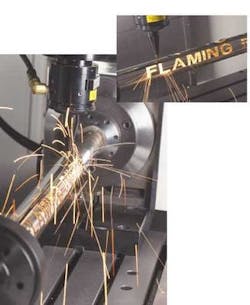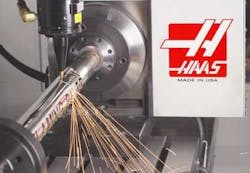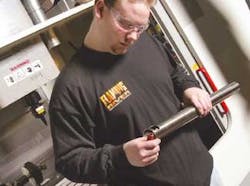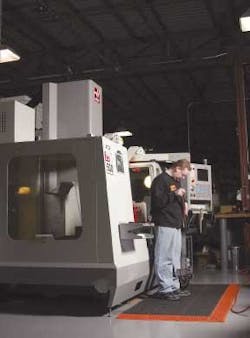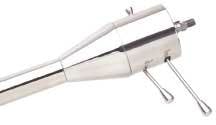Steering in the right direction
Laser system enables automotive aftermarket manufacturer to deliver a better product
Laser cutting systems are too complex, too expensive and too difficult to operate—at least, that's the perception many companies seem to have these days. Given that perception, its no wonder so many businesses sub-contract their laser cutting to specialized job shops.
Some companies, however, realize that if they want their business to move forward, they must put new technology into operation. Flaming River Industries of Berea, Ohio, is one company that saw the possibilities of laser cutting, invested in the technology and found success.
Flaming River manufactures accessories for the automotive aftermarket, specializing in rack-and-pinion systems, U-joints and steering columns for hot rods, dragsters and classic cars. The company's products are well recognized by rod builders, racers and restoration enthusiasts alike for their high quality and innovative designs.
Top:The laser cuts a tube with the name Flaming River.
The company's name has its origins in an incident that occurred on the nearby Cuyahoga River—which actually caught fire years ago because of the pollutants floating atop the water. "Wherever we would go around the country," explains Jeanette Ladina, president and CEO, "people would recognize Cleveland as the place where the river caught on fire. So the person who founded the company thought it would be a really cool concept to name the company Flaming River Industries."
Flaming River products, especially the company's custom steering columns, have developed quite a reputation with restoration shops and custom car builders. These groups previously had to rely on used or rebuilt steering columns for their projects, because new ones weren't available. Aware of the growing need, and seeing an opportunity, the folks at Flaming River stepped in to fill the void.
"We thought if we could give the customer products with all-new components, and price them competitively, then we would have a unique niche," explains Ladina.
It proved to be a smart move. Flaming River was the only manufacturer making new steering columns for classic cars, and customers were buying them as fast as the company could make them . . .which created a new problem: meeting the demand.
null
null
At first, the steel tubes for the steering columns were cut using a punch press, says Flaming River Vice President Ron Domin. "We started with the punch press because it was the most realistic and economical way to get started," he says. "But the punch press process was lengthy and sometimes required several dowel changes. It used to take us a week and a half to make 200 steering columns."
It simply wasn't enough. There had to be a better way, and "that's what started this whole thing with the laser," says Domin.
The company found a nearby job shop that had a laser machine that could cut the steel tubes, and began sub-contracting the work to them. It was a step in the right direction, but perhaps not the best option from a monetary standpoint. Domin explains: "We realized early on that if we continued outsourcing, we would be helping someone else buy a machine. That's when we decided to start looking to purchase a laser for ourselves."
The company looked at several different laser-cutting systems, and then talked with a Haas Automation Inc. sales engineer who said Haas could develop a turnkey system for them. "We wouldn't have been able to do it ourselves. We talked to a lot of other companies, and no one else had any interest in that at all," says Domin.
Domin and Ladina were sold on the Haas laser cutting system after visiting the company's headquarters in Oxnard, CA, where they saw a Z4-500 laser system cutting tubes just like the ones they had. "We went to California, and everyone there seemed very helpful to our project," says Ladina. "I really believe that if we had not visited the factory and met with the Haas staff, we would still just be talking about it."
Laser cutting is considered too difficult by many manufacturers, because they have no one on staff with laser experience. But Ladina felt her employees could handle almost anything. "At a lot of places, there is a fear of technology, but our employees are unique; they're excited to see us add new technology."
Flaming River purchased the Z3-500 laser cutting system, which features a 500-watt Coherent Diamond-Series laser, and had it installed in 2003. Dave Benadum, applications engineer with the Haas Factory Outlet in Solon, OH, designed their turnkey laser cutting system. Benadum began with a Haas HRT 210 rotary table and a tailstock. He put both devices on risers so that Flaming River could use the full xyz travels (40 in. × 20 in. × 25 in.) of the Z3-500, and to allow the laser to cut the ends of the tubes.
"With all the fixtures off the end of the table," Benadum explains, "it allows them to face both ends of the tube at the same time. They don't have to take the tube out and turn it around." The mandrels on the indexer and the tailstock are air-actuated, and expandable to hold different sized tubes. The tubes range in diameter from 1.25 inches to 4 inches.
It didn't take long for Flaming River to realize the benefits of the laser cutting system: increased production, more flexibility, better quality and faster assembly of steering columns.
"We used to do 200 pieces at a time on the punch press, and it would take a week and a half," says Domin. "Now we can do 200 columns in about three and a half hours.
"The laser gives us the versatility that we never had with the punch press," Domin continues. "One of the problems with the punch press is that you cannot make changes. The punch press is going to punch that hole in the same place no matter what. A lot of times we build columns for special applications, where we need to have the holes in a different place. With the laser, you can move the holes by fractions if you want to — in the same program."
The Z3-500 laser cutting system uses the standard Haas control, which allows for cylindrical mapping through a special G code. "The G47 code allows them to program the laser to cut a flat shape on the tube," says Benadum.
The company uses SolidWorks for programming, which gives them the ability to make design changes easily, depending on the model of the car. "If we have to change the design, all we have to do is change the program," notes Ladina.
The laser cutting system also enables Flaming River to build a better product. "Accuracy has improved considerably, because every piece of steel we cut is perfect. We don't have scrap. The machine doesn't make a mistake," says Domin. "With that laser, each hole is consistent. The steering systems are easier to assemble, because every column is the same. The alignments are there, whereas before, we had to deal with variances. So it is better for the guy building the column."
As for the future, Flaming River has the technology and manufacturing capability to develop new products with the laser. "We have a combination of excellent employees, good products and great customer feedback. Just about everything we have done has been from a customer coming to us and asking: 'Can you make this?'" relates Ladina.
The laser cutting system allows Flaming River to dedicate more time to what they do best—serving customers. "It's not rocket science," Domin explains. "All you have to do is listen to your customers, and they'll tell you what they're looking for and why they want to buy it from you."
Scott Weersing is a staff writer and photographer with Haas Automation. Contact [email protected].

